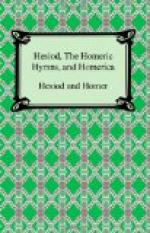Of the Hesiodic poems similar in character to the “Works and Days”, only the scantiest fragments survive. One at least of these, the “Divination by Birds”, was, as we know from Proclus, attached to the end of the “Works” until it was rejected by Apollonius Rhodius: doubtless it continued the same theme of how to live, showing how man can avoid disasters by attending to the omens to be drawn from birds. It is possible that the “Astronomy” or “Astrology” (as Plutarch calls it) was in turn appended to the “Divination”. It certainly gave some account of the principal constellations, their dates of rising and setting, and the legends connected with them, and probably showed how these influenced human affairs or might be used as guides. The “Precepts of Chiron” was a didactic poem made up of moral and practical precepts, resembling the gnomic sections of the “Works and Days”, addressed by the Centaur Chiron to his pupil Achilles.
Even less is known of the poem called the “Great Works”: the title implies that it was similar in subject to the second section of the “Works and Days”, but longer. Possible references in Roman writers (6) indicate that among the subjects dealt with were the cultivation of the vine and olive and various herbs. The inclusion of the judgment of Rhadamanthys (frag. 1): `If a man sow evil, he shall reap evil,’ indicates a gnomic element, and the note by Proclus (7) on “Works and Days” 126 makes it likely that metals also were dealt with. It is therefore possible that another lost poem, the “Idaean Dactyls”, which dealt with the discovery of metals and their working, was appended to, or even was a part of the “Great Works”, just as the “Divination by Birds” was appended to the “Works and Days”.
II. The Genealogical Poems: The only complete poem of the genealogical group is the “Theogony”, which traces from the beginning of things the descent and vicissitudes of the families of the gods. Like the “Works and Days” this poem has no dramatic plot; but its unifying principle is clear and simple. The gods are classified chronologically: as soon as one generation is catalogued, the poet goes on to detail the offspring of each member of that generation. Exceptions are only made in special cases, as the Sons of Iapetus (ll. 507-616) whose place is accounted for by their treatment by Zeus. The chief landmarks in the poem are as follows: after the first 103 lines, which contain at least three distinct preludes, three primeval beings are introduced, Chaos, Earth, and Eros — here an indefinite reproductive influence. Of these three, Earth produces Heaven to whom she bears the Titans, the Cyclopes and the hundred-handed giants. The Titans, oppressed by their father, revolt at the instigation of Earth, under the leadership of Cronos, and as a result Heaven and Earth are separated, and Cronos reigns over the universe. Cronos knowing that he is destined to be overcome by one of his children,




